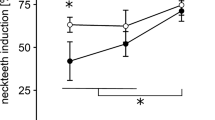Abstract
Daphnia magna can respond to chemical cues from freshly crushed conspecifics with various behavioural reactions. A shift in vertical distribution towards the bottom, the formation of aggregations and direct escape responses can all be induced by water-borne signals released from crushed Daphnia. The pattern and strength of the first two behavioural responses (i.e. the persistent tendency to occupy deeper strata in the experimental columns and to stay within patches) indicate that Daphnia perceive the signal from crushed conspecifics as nonspecific information, not necessarily associated with any particular kind of danger from either vertebrate or invertebrate predators. The adaptive value and possible costs associated with performing these two behavioural reactions are discussed. The adaptive value of the induced escape response was directly tested: Daphnia which had experienced the presence of a cue from crushed conspecifics avoided attacks by common bream more efficiently than naive Daphnia. The recognition of the signal originating from crushed conspecifics can be especially adaptive in encounters with unfamiliar predators and with predators that undergo ontogenetic shifts in their diet. Under natural conditions, the combination of such a signal with a predator cue can, very reliably, advertise the local scale of the predatory impact.
Similar content being viewed by others
Author information
Authors and Affiliations
Additional information
Received: 10 October 1996 / Accepted: 20 May 1997
Rights and permissions
About this article
Cite this article
Pijanowska, J. Alarm signals in Daphnia?. Oecologia 112, 12–16 (1997). https://doi.org/10.1007/s004420050277
Issue Date:
DOI: https://doi.org/10.1007/s004420050277




